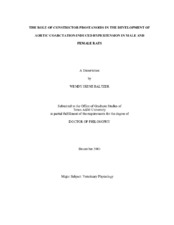| dc.description.abstract | Vascular reactivity to vasopressin and phenylephrine is potentiated by constrictor prostanoids (CP) in normotensive female (F) but not male (M) rat aorta and CP function is estrogen-dependent. This study investigated the effects of estrogen on CP function and arterial blood pressure (MAP) during development of aortic coarctation-induced hypertension (HT). M and F rats, (15-18 wks.) in four groups: normotensive (NT), hypertensive (HT), ovariectomized (OVX), and OVX estrogen-replaced (OE), underwent abdominal aortic coarctation or sham surgery (NT). At 14 days, SQ 29,548 (SQ, Thromboxane A2 (TXA2) receptor antagonist) was given i.v. to the groups. In another experiment, rats received Ridogrel (TXA2 receptor antagonist+TXA2 synthase (TXS) inhibitor) or vehicle (methyl cellulose) daily, for 14 days. Thoracic aortae were analyzed for morphology, incubated in Kreb’s Henseleit Buffer (KHB) ± angiotensin II (ANG II), or underwent continuous pulsatile flow and pressure experiments (PFP) with KHB ± ANG II. Perfusate was analyzed for thromboxane B2 (TXB2) and prostaglandin F1α (PGF1α). RT-PCR and immunohistochemistry were performed for TXS. MAP was higher in F-HT than in M-HT after 14 days. SQ infusion reduced MAP substantially more in F-HT and OE-HT than in others. Ridogrel prevented increases in MAP in F/OE-HT rats, but not M/OVX-HT. Basal release of TXB2 and PGF1α increased to a greater extent in F-HT than in M-HT relative to their controls. ANG II-stimulated TXB2 and PGF1α release increased to a greater extent in F-HT than in M-HT. With or without ANG II, TXB2 production in HT during PFP increased with estrogen. PGF1α increased during PFP with estrogen, however not with ANG II. Pressurization resulted in less diameter change in F and OE-HT than in OVX-HT. Elastin increased with HT (inhibited by Ridogrel) in all but M. Collagen increased in HT with estrogen (inhibited by Ridogrel). Neither OVX-HT nor Ridogrel had any effect on morphology. Estrogen increased TXS with HT. Estrogen enhanced vascular CP and MAP in F-HT by increased expression of TXS and collagen density in the vasculature indicating that in aortic coarctation-induced HT, CP are upregulated by estrogen. Specific forms of HT in human beings may involve estrogen-induced vascular CP upregulation. | en |


